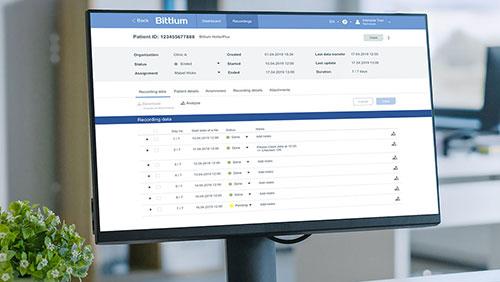Seamless and Secure Connectivity Program
Develops an end-to-end seamless and secure connectivity and communication of the future.

Program Summary
Seamless and Secure Connectivity program aims at enabling trustworthy, secure, and resilient end-to-end connectivity architectures and products including life-cycle services in various domains. Business Finland has granted the program EUR 10 million development funding and, in addition, EUR 20 million funding for the ecosystem companies and research partners. The four-year program led by Bittium will last until 2026. Achieving the goal requires active co-operation with various public and private contributors, including e.g. network, application, terminal and other devices providers combined with the various software and technology solution providers.
Focus Themes

Secure Encryption Technologies
The objective is to define and create roadmap to develop and apply future encryption technologies.

Seamless and Secure Connectivity for Highly Secure Communications in the Future Networks
The objective is to define ad solve special questions related to highly secure applications as well as application of related technologies and solutions.

Secure End-to-End Verticals
The objective is to develop end-to-end information security, including the development of information security in different verticals.

Scaled Sensor Fusion Development
As objective to define and create roadmap for the utilization of information from several sensors and thus sensor fusion based on, for example, medical measurement data.

Significant Development of Operating Models (e.g. RegOps, a Method of Agile Development of Medical Software)
The objective is to develop different operating models in such a way that they take into account the extensive requirements of regulations and directives, and the rapid adaptation or application of regulations and directives to software supporting devices or services.

Shifts from Devices into End-to-End Solutions and Services
As objective to develop technologies and solutions that enable the transfer of information from devices to solutions and services (end-to-end connections), for example in medical remote diagnostics.
Bittium Seamless and Secure Connectivity Veturi Event in Tampere
Join us for an exciting Seamless and Secure Connectivity program event featuring keynote speeches from distinguished speakers and discover what to expect from the program now and what is on the horizon for the future.
Registration opens in August.
Date: 9.9.2025
Location: Tampere Paidia – Living Lab of Play


Bittium Veturi & SW4E Collaboration Workshop
Bittium Veturi & SW4E Collaboration Workshop was held in Tampere!
Explore the future of RegOps, AI, and software engineering at this free collaborative workshop hosted by Bittium Veturi and the SW4E ecosystem. The event will feature expert presentations and hands-on workshops designed for anyone interested in these cutting-edge topics.
Seamless and Secure Connectivity Ecosystem Event
Bittium’s Seamless and Secure Connectivity Ecosystem Event with presentations from Bittium, BusinessFinland, VTT, JYU and University of Oulu, was held in Oulu on March 20.

Program Ecosystem
The ecosystem of the Seamless and Secure Connectivity Program will develop seamless digital structures, infrastructure, systems, and processes as well as cyber resilience suitable for the current, advanced 5th generation (5G advanced) and future 6G environments. In order to reach this goal, the perspective of overall development, from devices to services in the entire chain, must be taken into account.
Program Management
Jari Partanen
Veturi Program Lead
Jari Jauhiainen
Research Collaboration
CISSAN (Collective Intelligence Supported by Security Aware Nodes)
CISSAN builds methods and technology for integrating collective security intelligence to IoT networks. CISSAN-powered networks will be able to collaboratively identify tampered and adversarial devices, detect malicious activities, and select effective countermeasures. Higher IoT network resilience with be accompanied by resource efficiency through intelligent distribution of security functionalities across network nodes. CISSAN is EU CELTIC-NEXT project (https://www.celticnext.eu/project-cissan/). In Finland CISSAN belongs to Bittium´s Seamless and Secure Connectivity program funded by Business Finland.
Main focus
The proliferation of Internet of Things (IoT) has fundamentally changed how different environments, such as homes, offices, factories, smart buildings, and smart grids, are used and operated. However, security is a major concern for IoT networks and environments, where the risks of physical device tempering, injection of malicious devices, and unpatched vulnerabilities are higher than in traditional networks. CISSAN proposes and implements algorithms for mitigating IoT security threats through collective decision-making and with a reduced impact on the limited resources of IoT devices. These algorithms will be based on research and innovation in optimizing the distribution of security capabilities and aggregating the intelligence in IoT network nodes. Three industrial use cases, which nowadays heavily rely on the use of IoT, will inform the project developments and will be used for validating and demonstrating the project results: (i) public transportation; (ii) smart energy grids; (iii) mining and tunneling operations.
Approach
CISSAN will research and implement algorithms for distributed security monitoring, attack detection and response in IoT networks. Such algorithms will combine machine learning-based methods, more traditional AI techniques (e.g., decision-making based on formal knowledge representation and expert systems, fuzzy logic-based approaches, or genetic algorithms), and attack-specific rules. Since increasing the level of autonomy in IoT network defence is one of the high goals of the project, we will propose mechanisms for collective decision-making by CISSAN “security agents”, which are essentially security functions placed to IoT network nodes. Blockchain-based consensus protocols are one possible type of such mechanisms to be considered in the project. To enable communication between the security agents, CISSAN will implement a light overlay networking solution. Also, methods and tools will be developed for verifying the quality of data sets used in the project for building machine learning models and supporting other data-driven technologies.
IoT devices are usually resource-constrained, and instrumenting each of them with the full set of security functions required for detecting and countering cyberattacks may not be an optimal strategy. Instead, we will propose network context-aware algorithms for distributing the security functions among the IoT devices, edge devices, and possibly cloud backends to achieve a suitable balance between the network resilience and the resource utilization.
The technical efforts in CISSAN will be accompanied by defining and investigating potential business models around the project results and their business impact analysis. Regulatory and compliance considerations will be taken into account, including the ENISA’s work on certification schemes.
Partners
AddSecure Smart Grids (SE), Affärsverken Karlskrona (SE), Arctoslabs AB (SE), Blekinge Tekniska Högskolan (SE), Blue Science Park (SE), Cibernos (ES), Clavister AB (SE), Councilbox (ES), Geodata Ziviltechnikergesellschaft mbH (AT), Mattersoft Ltd. (FI), Mint Security Ltd. (FI), Netox (FI), Nodeon Finland Oy (FI), Savantic (SE), ScopeSensor Ltd. (FI), Techinova AB (SE), University of Jyväskylä (FI), Wirepas Oy (FI) and Bittium (Veturi leading company)
Contact
Contact for the CISSAN project is [email protected]
More information on the project can be found from our website: https://www.celticnext.eu/project-cissan/
PhotonWear (Wearable Technologies for Photonic Sensors)
Demographic change and the need for cost-effective solutions for health and elderly care is one of the biggest global challenges. Wearable sensors are fundamental to monitoring of health and wellness for their inherent advantages: non-invasive measurements, continuous data collection and wireless connectivity. PhotonWear will rely on novel optical sensing methods for physiological parameters, advanced data analytics, and manufacturing and integration methods for conformable electronics. Project will focus on optical non-invasive measurement of different physiological parameters and biomarkers, using ultra-comfortable sensors for healthcare and wellness applications, such as patient monitoring, apnea detection, heart health and metabolic monitoring. PhotonWear aims are:
- Digital twin of the human – optical model of human tissue by simulation toolset and with the help of using realistic physical models of human skin and body parts
- High-accuracy optical measurements – research tools and methodologies for medical quality optical measurements by a robust multispectral system capable for acquiring data with easily reconfigurable settings.
- Demonstrators validated with a volunteer group – ultra-comfortable, flexible/stretchable skin patch optical sensor providing medical quality performance for heart rate and blood oxygenation measurements, including photodiode technology with 20% higher sensitivity than with state-of-the-art technologies and capability to measure non-invasive blood pressure.
- Novel optical measurement of lactate and glucose levels – radical and innovative idea for proof-of-concept non-invasive measurement of lactate and glucose levels directly from human tissue.
PhotonWear is composed of industrial leaders in Finland in both healthcare and in wellness, as well as in novel photonics technologies. Academic partners will help in bringing novel, beyond state-of-the-art technologies and innovations into use of Finnish wearable technologies ecosystem.
PhotonWear aims to combine international networking with close national collaboration to develop new wearable technologies for photonic analyzers as well as value chains that lead to new scientific know-how, significant industrial business and new jobs in Finland.
PhotonWear project partners are VTT (coordinator), GE Healthcare, OURA, Elfys, University of Oulu and Bittium (Veturi leading company).
Contact for the PhotonWear project is [email protected]
LFF – LifeFactFuture
LifeFactFuture (LFF) is a large consortium project including research teams at the University of Turku and the University of Helsinki, as well as some of Finland’s leading life science manufacturers, data and technology companies. Project is funded by Business Finland during 2024–2026. The goal of the collaboration is to speed up the introduction of digital solutions and more efficient utilization of data and to make Finland the most attractive place in the world for investments in data-driven life science manufacturing.
The LifeFactFuture (LFF) project combines world class-excellence of Finnish life science companies, technology companies and academic researchers. It seeks to enhance advanced pharmaceutical and life science manufacturing in Finland. The LFF consortium includes research teams at the University of Turku and the University of Helsinki, as well as some of Finland’s leading life science manufacturers, data and technology companies. The goal of the project collaboration is to speed up the introduction of digital solutions and more efficient utilization of data and to make Finland the most attractive place in the world for investments in data-driven life science manufacturing. Current global vendors for pharmaceutical manufacturing are not able to provide the critical future data capabilities already identified by the sector in Finland. The data-driven capabilities offered by life science manufacturing vendors are assessed as less mature than similar solutions for other manufacturing sectors such as the automotive industry. If Finland becomes the lighthouse for exploiting new data-driven capabilities in advanced life sciences manufacturing, new billion-euro export opportunities are on the horizon. The export potential is considerable within the life science sector itself as well as within technology industry companies supplying the life science sector with data-driven capabilities.
Partners
University of Turku (coordinator), University of Helsinki, Bayer, Orion, Wallac, Darekon, Brightly Works, Nokia (Veturi leading company), Vaisala, Care4Living, Dain Studios and Bittium (Veturi leading company)
Contact
Contacts for the LFF project is [email protected] (Interaction Coordinator) and [email protected] (Consortium Leader)
More information on the project can be found from our website: https://sites.utu.fi/lifefactfuture/
DistriMuSe (DISTRIBUTED MULTI-SENSOR SYSTEMS FOR HUMAN SAFETY AND HEALTH) Horizon-KDT-JU-RIA
DistriMuSe project is an EU Key Digital Technologies (KDT) project.
In Finland DistriMuSe belongs to Bittium´s Seamless and Secure Connectivity program funded by Business Finland.
DistriMuSe intends to support human health and safety by improved sensing of human presence, behavior and vital signs in a collaborative or common environment by means of multi-sensor systems, distributed processing and machine learning. In practice, we will study a variety of technologies ranging from sensor hardware to edge and cloud-based AI to better observe people, both their behavior and their health. This will be done in three main use cases. The first is focusing on human health, particularly of elderly and related to sleep and exercise. The second use case aims to ensure the safety of pedestrians and cyclists in traffic, both by observing them and the drivers of cars. The third use case studies how to improve interaction between robots and humans in a collaborative factory environment while keeping the humans safe. The project brings together 50 partners from 7 countries, resorts under Chips JU and is funded partially by the EU and by the national funding agencies from the participating countries.
More information on the project can be found from our website: https://distrimuse.eu
Partners
DistriMuSe project partners are VTT (coordinator, ACORDE TECHNOLOGIES SA, AITEK SOCIETA PER AZIONI, BENETE OY, BITTIUM (Veturi leading company), ROBERT BOSCH GMBH, VYSOKE UCENI TECHNICKE V BRNE, CAMEA SPOL SRO, CONSIDER IT GMBH, COMMETO, AGENCIA ESTATAL CONSEJO SUPERIOR DE INVESTIGACIONES, ELIVE ECOSYSTEM OY, EMOJ SRL, EVALAN BV, ODIN SOLUTIONS SOCIEDAD LIMITADA, FINAPRES MEDICAL SYSTEMS BV, FLIR SYSTEMS TRADING BELGIUM BVBA, HI IBERIA INGENIERIA Y PROYECTOS SL, PISO BAJ, STICHTING IMEC NEDERLAND, INFINEON TECHNOLOGIES AG, INSTITUT MIKROELEKTRONICKYCH APLIKACI SRO, INTERUNIVERSITAIR MICRO-ELECTRONICA CENTRUM, INSTITUT DE RECERCA BIOMEDICA DE LLEIDA FUNDACIO DOCTOR PIFARRE, STICHTING KEMPENHAEGHE, KATHOLIEKE UNIVERSITEIT LEUVEN, MACQ SA, PRODRIVE TECHNOLOGIES INNOVATION SERVICES B.V., PUMACY TECHNOLOGIES AG, RE:LAB SRL, RESILTECH SRL, RU LEX INNOVATION LABS SRL, SAFRAN ELECTRONICS & DEFENSE SPAIN SOCIEDAD LIMITADA, EVENTIGRATE, SMART ROBOTICS BV, TELEVIC, TRILITEC GMBH, TECHNISCHE UNIVERSITAET DRESDEN, TECHNISCHE UNIVERSITEIT EINDHOVEN, University of Eastern Finland, UNIVERSITEIT GENT, ALMA MATER STUDIORUM – UNIVERSITA DI BOLOGNA, UNIVERSITAET BREMEN, UNIVERSIDAD DE GRANADA, UNIVERSITA DEGLI STUD! DI PARMA, UNIVERSITA DEGLI STUD! SUOR ORSOLA BENINCASA, UNIVERSITA DEGLI STUD! DI TORINO, UNIVERSIDAD DE VIGO, VALOSSA LABS OY, XENOMATIX, PICTM TECHNOLOGIES OY
Contact
Contact for the DistriMuSe project is [email protected]
RF ECO3 – Economical and Ecological RF Ecosystem
RF ECO3 project address challenges related to radio frequency (RF) design for ultra-fast communication and potential for high-resolution sensing in forthcoming 6G radio systems towards ecological and economic benefits for society and industry. Hardware components and their efficient design for future application requirements are indisputable assets for the industrial success of extremely complex radios targeted for new applications in 6G. Those include vastly enhanced capacity for communications as well as the opportunity to sense objects and environment simultaneously. Energy efficiency and resilience in different environmental conditions to attacks (like interference in GPS navigation) are core problems that the project addresses towards increasingly complex spectral view in 5G advanced and 6G radios. RF design is a specialized skill transferring wireless information from radio waves to data in digitalized society. Competence is a mandatory asset for companies excelling in the field. The project has partners that have world class expertise in different areas of RF engineering from immense complex systems to testing, antennas, chip design and aligned technologies complemented with the leading research organizations in Finland providing depth and breadth to the underlying challenges towards 6G. Productivity in research and development is key problem in modern and highly complex RF designs. Machine learning and AI methods offer new opportunities to boost efficiency and performance – in both communication networks and design tools, still at very early stage in RF that require domain specific expertise to adopt for the benefit of the industry. Project is a part of the national Veturi programs of the two partnering companies.
Partners
University of Oulu (coordinator), Aalto university, University of Tampere, VTT, Verkotan, SAAB, Senfit, Optenni, Nokia (Veturi leading company), CoreHW and Bittium (Veturi leading company)
Contact
Contact for the RF ECO3 project is [email protected]
More information on the project can be found from our website: https://rf-eco3.rf-hub.org/
BLimPQC (Beyond the Limits of Post-Quantum Cryptography)
The BlimPQC – Beyond the Limits of Post-Quantum Cryptography project investigates the possibilities and limitations of new Post-Quantum Cryptography methods and the requirements for different devices and software where encryption is used. In the long term, quantum computing and quantum computers pose a significant threat to the currently widely used public key encryption methods. These threats can be mitigated with post-quantum cryptography, and due to recent developments, the standardization of new methods has progressed rapidly and was available 2024.
This project explores the use and limitations of these new encryption algorithms that will be standardized, and studies the possibilities of quantum computing in breaking encryption methods. In addition to encryption algorithms, we investigate the use of quantum key exchange and key management. New methods are implemented in the use cases of different companies. We also make a review of quantum security regulation and requirements abroad, especially in the United States, where the first related law was set already in December 2022. During the project, high-level guidelines are created and published for relevant stakeholders based on the findings of research and experiments.
Partners
BLimPQC project partners are VTT (coordinator), Bittium (Veturi leading company), Aalto university, Oy L M Ericsson Ab, Icareus Oy, Jutel Oy, SSH Communications Security Oyj, University of Helsinki, University of Oulu, Xiphera Oy and external stakeholders: Digi- ja väestötietovirasto, Finnish Defence Forces, Traficom
Contact
Contact for the BLimPQC project is [email protected]
MAISA (Managed AI-Assisted Software Innovations
Project scope is in software development which is a key enabler for practical software industrial excellence of Finnish export companies, i.e., customer companies of MAISA consortium. The success of Finnish industry is heavily dependent on efficient execution of software engineering* with the state-of-the-art solutions. Thus, the main objective is to develop a new concept framework for AI-powered software engineering including seamless integration of safe, secure and trustworthy tools and processes to ultimately leverage AI for decision making and enhanced automation in software engineering.
Partners
University of Tampere (coordinator), Demola, Eficode, Netum, KELA, KONE (Veturi leading company), Koivu Solutions, Liana Technologies, LUT university, University of Oulu, TietoEvry (Veturi leading company), Bittium (Veturi leading company), Q4US
Contact
Contact for the MAISA project is [email protected]
More information on the project can be found from forth coming website (to be launched soon).